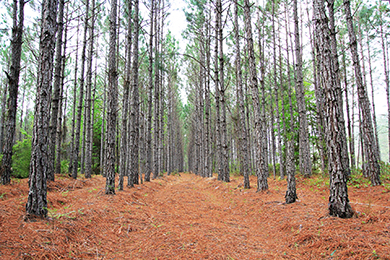More than 3,600 acres of Brunswick County forest is permanently protected thanks to a collaborative effort between Apple Inc. and The Conservation Fund.
The recent acquisition is part of the computer giant’s latest environmental initiative – one aimed to protect “working” forests in an effort to offset the amount trees that are cut down to supply Apple’s packaging needs.
Supporter Spotlight

“They estimated their pulp and fiber usage for half their major products in 2014 and then purchased these properties to offset that amount,” said Robin Murphy, senior vice president of marketing and communications for The Conservation Fund.
After looking at a number of properties throughout the country, the nonprofit environmental organization helped Apple select more than 36,000 acres of forest in the eastern United States.
Apple funded the purchase. The company is not disclosing the purchase price. The land will be managed by The Conservation Fund.
With its high-quality pine savannahs and variety of unusual plants and flowers, the Brunswick County forest has been a conservation priority.
The forest is home to rare orchids and carnivorous plants, including the Venus flytrap and pitcher plants. It’s also inhabited by several rare species of woodpeckers, sparrows and butterflies.
Supporter Spotlight
The forest is near Winnabow, an unincorporated community in Brunswick County, which is among the 100 fastest growing counties in the nation, according to the U.S. Census Bureau.
The forestland is adjacent to the 16,176-acre Green Swamp Preserve managed by The Nature Conservancy.
Apple also bought more than 32,000 acres in Aroostook County, Maine, where wetlands, rivers and upland forest are home to Atlantic salmon, bald eagles and Canada lynx.
“Apple isn’t necessarily going to be accessing pulp and fiber from Brunswick or the other property that was acquired in May,” Murphy said. “It is the same result, if you will, by having an offset, by protecting that many acres.”
Since the late 1990s, the environmental organization’s Working Forest Fund has sought to buy and protect America’s last big, intact, privately held forests managed for timber products. More than 400,000 acres in 13 states have been acquired.

There are more than 420 million acres of “working” forests in the country. During the last 15 years, more than 23 million acres of forestland harvested for pulp, paper and solid wood material has been sold, resold and parceled into smaller tracts for development. Another 45 million acres are at risk of the same happening to it, according to The Conservation Fund.
“It’s urgent,” Murphy said. “They’re being sold off.”
The fund aims to acquire as many as five million acres over time, he said.
Forests bought through the fund are permanently protected through conservation easements and managed by sustainable forest plans.
These plans are based on information gathered about the forests. Everything from the ages and sizes of the trees to the attributes of the land relative to conservation value are thoroughly studied.
“The idea is to keep the forest working,” said Brian Dangler, director of the Working Forest Fund.
Sustainable forests are selectively harvested and local people – everyone from loggers, truckers and road maintenance crews – are used in the harvesting process.
It is unclear when the Brunswick forest will be harvested. Forestry experts are in the early stages of creating a management plan for the forest, Dangler said.
“It takes time to gather all of the data that is needed to create a management plan and understand the property,” he said.
The Working Forest Fund acquires and permanently protects working forests of high conservation value.
The forestland will eventually be sold back to a private owner or public agency stewardship.
A conservation easement will be placed on the property, ensuring that it will be protected as a “working” forest under future ownership.
Representatives for Apple did not respond to requests for comment.
This initial purchase by the company of U.S. forests is “the beginning of a worldwide effort,” according In a letter penned by Lisa Jackson, the head of Apple’s environmental initiatives and Larry Selzer, president and CEO of The Conservation Fund.
“Keeping these working forests intact will ensure continued fiber production and protect jobs and recreational opportunities,” the letter states. “The collective annual production of paper fiber from these two forests is equivalent to nearly half of the virgin fiber that went into iPhone, iPad, iPod, Mac and Apple TV packaging last year.”
The acquisition is the latest in the company’s environmental initiatives.
All of Apple’s U.S. facilities and operations are powered by 100 percent renewable energy. The company hopes to do the same in its 450 retail stores across the world.
According to Apple’s 2014 Environmental Responsibility Report, which covered the 2013 fiscal year, the company has reduced the amount of aluminum and steel used in its Mac Pro. The newest iMac is made with 68 percent less material than the first generation iMac.
Dangler said that Apple’s goal is to minimize their use of forest consumption.
“They want to be an example to other industry users,” he said.
Murphy said The Conservation Fund hopes that is the case.
“We very much hope that other companies will emulate that leadership,” he said.







